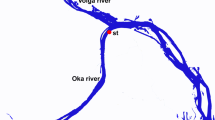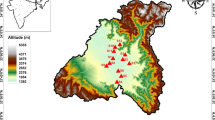Abstract
We studied the composition and density of the algae of the littoral epilithon and the taxa turnover in nine lentic water bodies at Hope Bay, Antarctic Peninsula, during summer 2002. At each site we measured the main physical and chemical variables, and took epilithic samples for the algal analysis. Two composed samples (one for qualitative and one for quantitative analysis) were taken randomly about 1 m away from the shore-line of each sampling site. The morphology of the algal mats could be included in the ‘moat and pond type’ in which Cyanobacteria are well represented. A total of 69 algal taxa were recorded in the whole study area. Chlorophyceae showed the highest taxa richness (33%), followed by Cyanobacteria (29%), Bacillariophyceae (26%), Chrysophyceae (10%), and Tribophyceae (2%). As a result of the redundancy analysis performed, we found that the number, composition, and density of taxa in the water bodies at Hope Bay were strongly influenced by nitrate and suspended solids concentrations and by the distance from the sea. The geographical trend in taxa turnover within Hope Bay was explained by elements from the combination of the metapopulation dynamics and the continuum theories, which are related to dispersal limitation and environmental heterogeneity, respectively.






Similar content being viewed by others
References
American Public Health Association (1992) Standard methods for the examination of water and wastewaters. APHA, Washington, DC
Anagnostidis K, Komárek J (1988) Modern approach to the classification system of cyanophytes. 3. Oscillatoriales. Archiv Hydrobiol (Suppl) 80:327–472
Bourrelly P (1970) Les algues d’eau douce. III. N. Boubée, París
Bourrelly P (1981) Les algues d’eau douce. II. N. Boubée, París
Broady PA (1982) Taxonomy and ecology of algae in freshwater stream in Taylor Valley, Antarctica. Archiv Hydrobiol 63:331–349
Broady PA (1986) Ecology and taxonomy of terrestrial algae of Vestfold Hills. In: Pickard J (ed) Antarctic Oasis, Academic Press, Sydney, pp 165–202
Brown JH, Kodric-Brown A (1977) Turnover rates in insular biogeography: effect of immigration and extinction. Ecology 58:445–449
Chase JM (2003) Community assembly: when should history matter? Oecologia 136:489–498
Chipev N, Temniskova-Topalova D (1999) Diversity, dynamics and distribution of diatom assemblages in land habitats on the Livingston Island (the Antarctic). Bulgarian Antarct Res Life Sci 2:32–42
Cordier JR, Mendez A, Mougin JL, Visbeek G (1983) Les oiseaux de la baie de l´Espérance, Péninsule antartique (63°24′S, 56°59′W). L’Oiseau et RFO 53:140–276
Cottam G, McIntosh RP (1996) Vegetation continuum. Science 152:546–547
De Wolf H (1982) Method of coding of ecological data from diatoms for computer utilization. Meded Rijks Geol Dienst 36:95–98
Ellis-Evans JC (1996) Microbial diversity and function in Antarctic freshwater ecosystems. Biodivers Conserv 5:1395–1431
Ermolin E (2003) Primera experiencia en diseño y construcción de un dique en permafrost antártico: lago Boeckella, Bahía Esperanza. Contrib Inst Antárt Argent 537:1–41
Ettl H (1978) Xanthophyceae. Pascher Süsswassweflora von Mitteleuropa. Fischer, Suttgart, New York
Fumanti B, Alfinito S, Cavacini P (1995) Floristic studies on freshwater algae of Lake Gondwana, Northern Victoria Land (Antarctica). Hydrobiologia 316:81–90
Fumanti B, Cavacini P, Alfinito S (1997) Benthic algal mats of some lakes of inexpressible Island (northern Victoria Land, Antarctica). Polar Biol 14:25–30
Geitler L (1932) Cyanophyceae. Kryptogamen-Flora von Deutschland, Osterreich und der Schweiz, 14. Akad Verlagsges, Leipzig
Hanski I (1999) Metapopulation ecology. University Press, Oxford
Hanski I, Gilpin ME (1997) Metapopulation biology: ecology, genetics and evolution. Academic Press, London
Hawes I (1989) Filamentous green algae in freshwater streams on Signy Island, Antarctica. Hydrobiologia 172:1–18
Hawes I, Moorhead D, Sutherland D, Schmeling J, Shwarz A-M (2001) Benthic primary production in two perennially ice-covered Antarctic lakes: patterns of biomass accumulation with a model of community metabolism. Antarct Sci 13:18–27
Heegaard E (2004) Trends in aquatic macrophyte species turnover in Northern Ireland—which factors determine the spatial distribution of local species turnover? Global Ecol Biogeogr 13:397–408
Hüber-Pestalozzi G (1941) Chrysophyceen. In: Thienemann A (eds) Die Binnengewässer. Das Phytoplankton des Süsswassers 16/2. Nägele and Obermiller, Stuttgart
Howard-Williams C, Vincent CL, Broady PA, Vincent WF (1986) Antarctic stream ecosystems: variability in environmental properties and algal community structure. Internat Rev Gesam Hydrobiol 71:511–544
Izaguirre I, Mataloni G, Vinocur A, Tell G (1993) Temporal and spatial variations of phytoplankton from Boeckella Lake Hope Bay, Antarctic Peninsula. Antarct Sci 5:137–141
Izaguirre I, Pizarro H (1998) Epilithic algae from a glacial stream of Hope Bay (Antarctica). Polar Biol 19:24–31
Izaguirre I, Vinocur A, Mataloni G, Pose M (1998) Phytoplankton communities in relation to trophic status in lakes from Hope Bay Antarctic Peninsula. Hydrobiologia 369/370:73–87
Kawecka B, Olech M (1993) Diatom communities in the vanishing and Ornithologist Creek, King George island, South Shetlands, Antarctica. Hydrobiologia 269/270:327–333
Kawecka B, Olech M, Nowogrodzska-Zagórrska M, Wojtun B (1998) Diatom communities in small water bodies at H. Artowski Polish Antarctic Station (King George Island, South Shetland Islands, Antarctica). Polar Biol 19:183–192
Kellogg TB, Kellogg, DE (2002) Non-marine and littoral diatoms from Antarctic and subantarctic regions distribution and updated taxonomy. In: Witkowski A (eds) Diatoms monographs, vol.1. ARG Gantner Verlag KG, Vaduz, pp 1–795
Kirk JTO (1994) Light and photosynthesis in aquatic ecosystems. Cambridge University Press, Cambridge
Komárek J, Fott B (1983) Chlorophyceae, Chlorococcales. In: Hüber-Pestalozzi G (ed) Das Phytoplankton des Süsswasser. Die Binnengewässer, 16. Schweitzerbart’sche, Stuttgart
Komárek J, Anagnostidis K (1986) Modern approach to the classification system of cyanophytes. 2. Chroococcales. Archiv Hydrobiol (Suppl) 73:157–226
Krammer K, Lange-Bertalot H (1986) Bacillariophyceae. 1. Naviculaceae. In: Ettl H, Gerloff J, Heying H, Mollenhauer D (eds) Süsswasserflora von Mitteleuropa. Fischer, Jena
Krammer K, Lange-Bertalot H (1988) Bacillariophyceae. 2. Epithemiaceae, Surirellaceae. In: Ettl H , Gerloff J, Heying H, Mollenhauer D (eds) Süsswasserflora von Mitteleuropa. Fischer, Jena
Krammer K, Lange-Bertalot H (1991) Bacillariophyceae. 3. Centrales, Fragilariaceae, Eunotiaceae. In: Ettl H, Gerloff J, Heying H, Mollenhauer D (eds) Süsswasserflora von Mitteleuropa. Fischer, Jena
Lewis Smith RI (1984) Terrestrial plant biology of the subantarctic and Antarctic. In: Laws W (ed) Antarctic ecology, vol 1. Academic Press, London
Mackereth JFH, Hiron J, Talling JF (1978) Water analysis: some revised methods for limnologists. Freshwater Biology Association, Ambleside
Magurrran AE (1988) Ecological diversity and its measurements. Chapman and Hall, London
Marker AFH, Crowther CA, Gun RJM (1980) Methanol and acetone as solvents for estimating chlorophyll a and phaeopigments by spectrophotometry. Ergebnisse der Limnologie 14:52–69
Mouquet N, Loreau M (2002) Coexistence in metacommunities: the regional similarity hypothesis. Am Nat 159:420–426
Oksanen J, Minchin PR (2002) Continuum theory revisited: what shape are species responses along ecological gradients? Ecol Model 157:119–129
Oppenheim DR (1990) A preliminary study of benthic diatoms in contrasting lake environments. In: Kerry KR, Hempel G (eds) Antarctic ecosystems. Ecological change and conservation. Springer, Berlin Heidelberg New York, pp 91–99
Palmer MA, Hakenkamp CC, NelsonBaker K (1997) Ecological heterogeneity in streams: why variance matters. J N Am Benthol Soc 16:189–202
Parker BC, Wharton Jr R (1985) Physiological ecology of bluegreen algal mats (modern stromatolites) in Antarctic oasis lakes. Archiv Hydrobiol Algol Stud 38/39:331–348
Pizarro H, Izaguirre I, Tell G (1996) Epilithic algae from a freshwater stream of Hope Bay, Antarctica. Antarct Sci 8:161–167
Pizarro H, Vinocur A (1998) Cuerpos de agua lóticos de Bahía Esperanza (Antártida). Comparación en base a parámetros físico-químicos y a la comunidad de algas epilíticas. Contrib Inst Antárt Argent 465:1–23
Pizarro H, Vinocur A (2000) Epilithic biomass in an outflow stream at Potter Peninsula, King George Island, Antarctica. Polar Biol 23:851–857
Pizarro H, Vinocur A, Tell G (2002) Periphyton on artificial substrata from three lakes of different trophic status at Hope Bay, Antarctica. Polar Biol 25:169–179
Pizarro H, Allende L, Bonaventura SM (2004) Littoral epilithon of lentic water bodies at Hope Bay, Antarctic Peninsula: biomass variables in relation to environmental conditions. Hydrobiologia 529:239–253
Pulliam HR (1988) Sources, sinks and population regulation. Am Nat 132:652–661
Riaux-Gobin C, Compere P (1996) Observations sur le polymorphisme de Cocconeis californica Grunow, aux îles Kerguelen. Diatom Res 11:89–103
Romesburg HCh (1984) Cluster analysis for researchers. Lifetime Learning Publications, Belmont, CA
Sand-Jensen K, Borum J (1991) Interactions among phytoplankton, periphyton, and macrophytes in temperate freshwaters and estuaries. Aquat Bot 41:137–175
Sabbe K, Hodgson DA, Verleyen E, Taton A, Wilmotte A, Vanhoutte K, Vyverman W (2004) Salinity, depth and structure and composition of mircrobial mats in continental Antarctic lakes. Freshwat Biol 49:296–319
Shmida A, Wilson MV (1985) Biological determinants of species diversity. J Biogeogr 12:1–20
Simonsen R (1979) The diatom system. Ideas on phylogeny. Bacillaria 2:9–71
Stevenson RJ (1996) An introduction to algal ecology in freshwater benthic habitats. In: Stevenson RJ, Bothwell ML, Lowe RL (eds) Algal ecology. Freshwater benthic ecosystems. Academic Press, San Diego
Tatur A (1989) Ornithogenic soils of the maritime Antarctic. Pol Polar Res 10:481–532
Tell G, Vinocur A, Izaguirre I (1995) Cyanophyta of lakes and ponds of Hope Bay, Antarctic Peninsula. Polar Biol 15:503–509
Ter Braak CJF, Smilauer P (1998) CANOCO. Reference manual and user’s guide to Canoco for windows: software for Canonical Community Ordination (Version 4). Microcomputer Power, Ithaca, NY
Tessier M, Gloaguen JC, Bouchard V (2002) The role of spatio-temporal heterogeneity in the establishment and maintenance of Sueada maritime in salt marshes. J Veg Sci 13:115–122
Tilman D (1982) Resource competition and community structure. Princeton University Press, Princeton, NY
Utermöhl H (1958) Zur vervollkommnung der quantitativen Phytoplankton Methodik. Mit Int Verein Theor Angew Limnol 9:1–38
Van Dam H, Mertens A, Sinkeldam J (1994) A coded checklist and ecological indicator values of freshwater diatoms from The Netherlands. Neth J Aquat Ecol 28:117–133
Van den Hoek C, Mann DG, Jahns HM (1995) Algae. An introduction to phycology. Cambridge University Press, Cambridge
Venrick EL (1978) How many cells to count?. In: Sournia A (ed) Phytoplankton manual. UNESCO, Paris, pp 167–180
Vincent WF (2000) Cyanobacterial dominance in polar regions. In: Whitton B, Potts M (eds) The ecology of cyanobacteria. The diversity in time and space. Kluwer Academic, Dordrecht
Vinocur A, Izaguirre I (1994) Freshwater algae (excluding Cyanobacteria) from nine lakes and pools of Hope Bay, Antarctic Peninsula. Antarct Sci 6:483–489
Vinocur A, Pizarro H (1995) Periphyton flora of some lotic and lentic environments of Hope Bay (Antarctic Peninsula). Polar Biol 15:401–414
Vinocur A, Pizarro H (2000) Microbial mats of twenty-six lakes from Potter Peninsula, King George Island, Antarctica. Hydrobiologia 437:171–185
Wharton RA, Parker BC, Simmons GM (1983) Distribution, species composition and morphology of algal mats in Antarctic Dry Valley lakes. Phycologia 22:355–365
Wasell A, Hakansson H (1992) Diatom stratigraphy in a lake on Horseshoe Island, Antarctica: a marine-brackish-fresh water transition with comments on the systematics and ecology of the most common diatoms. Diatom Res 7:157–194
Whittaker RH (1967) Gradient analysis of vegetation. Biol Rev 42:207–264
Zipan W, Deprez PP (2000) Study on ecological structures of coastal lakes in Antarctic continent. Chin J Polar Sci, 11:147–160
Acknowledgments
Thanks are due to members of Esperanza Station (CAV 2002) for logistic support. This work was supported by ANCYPT (BID 202/OC-AR-PICT 04540), CONICET (PEI 1194/03), and the Argentine Antarctic Institute. We are thankful to Dr. F. Hindák and an unknown referee for their valuable comments on the manuscript.
Author information
Authors and Affiliations
Corresponding author
Rights and permissions
About this article
Cite this article
Bonaventura, S.M., Vinocur, A., Allende, L. et al. Algal structure of the littoral epilithon in lentic water bodies at Hope Bay, Antarctic Peninsula. Polar Biol 29, 668–680 (2006). https://doi.org/10.1007/s00300-005-0104-3
Received:
Revised:
Accepted:
Published:
Issue Date:
DOI: https://doi.org/10.1007/s00300-005-0104-3




